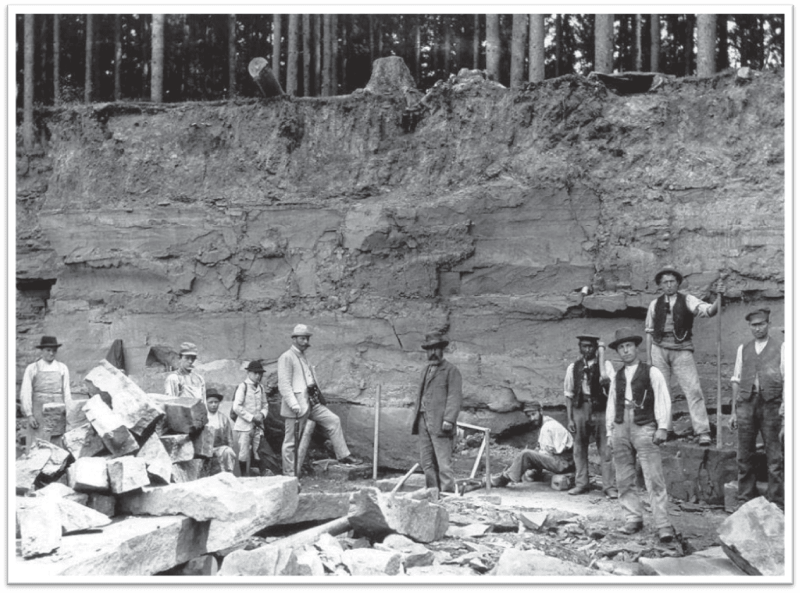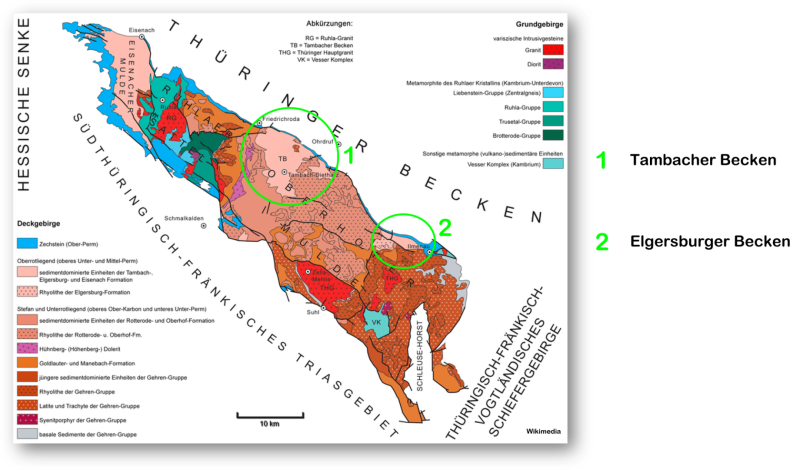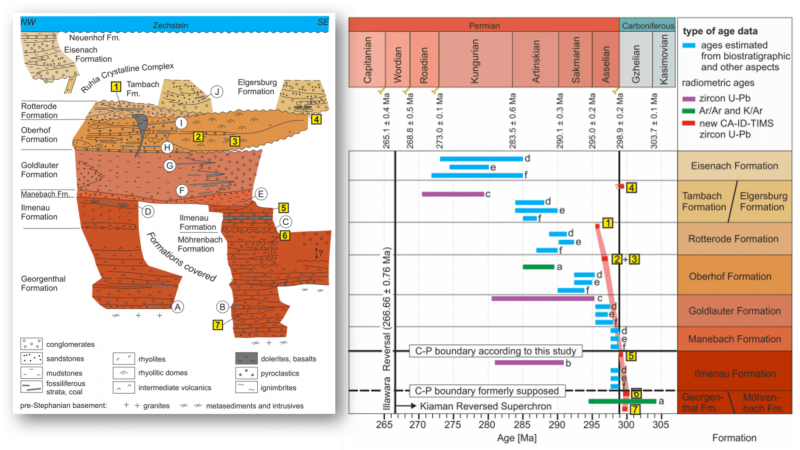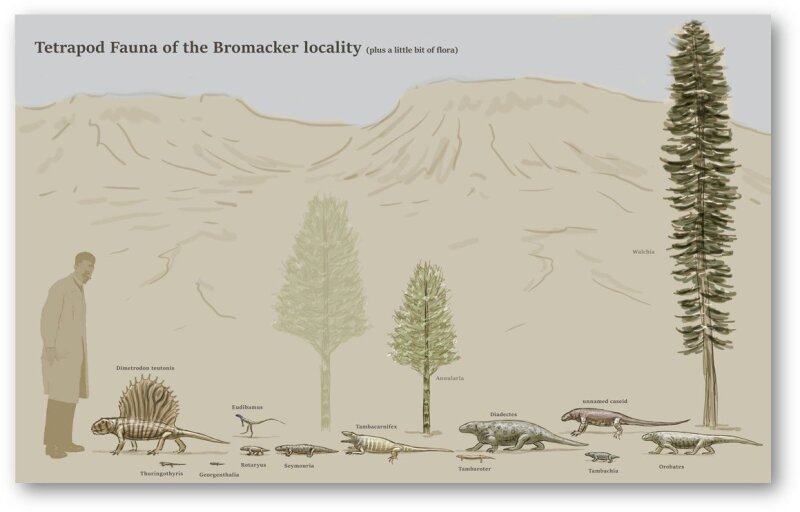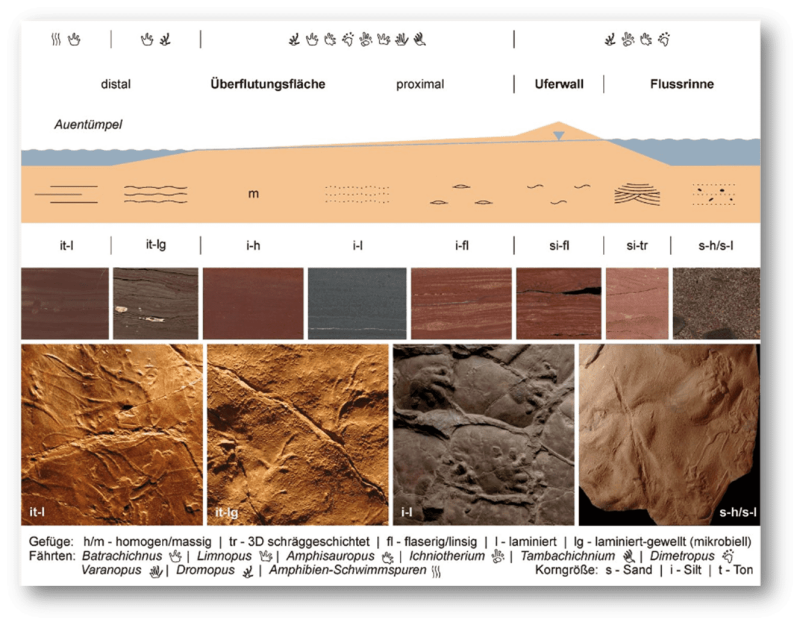Bromacker
The "Bromacker" fossil site in the Lower Permian Tambach Formation near the town of Tambach-Dietharz in the Thuringian Forest has been known for more than 100 years and represents one of the most important and productive fossil sites for terrestrial vertebrates (terrestrial tetrapods) from the Lower Permian (about 290 million years ago) outside the USA(Pabst, 1895; Martens, 2018). The site is unique in the world in terms of the first-rate preservation of the fossils as well as their exceptionally high species diversity (diversity), thereby providing invaluable insight into the paleobiology and ecology of early terrestrial vertebrates and their environment. In addition, it represents the only fossil deposit of this time in the world where body fossils and trace fossils are preserved simultaneously at the population level (Voigt et al., 2007). It is also unusual in that the fauna represents an upland fauna, which is very rare due to preservation conditions (Eberth et al., 2000). Only the Fort Sill lag site in the U.S. also represents a lower Permian highland fauna, providing an excellent basis for comparison in faunal and biogeographic studies (MacDougall et al., 2017). The importance of the "Bromacker" fossil site for documenting the early evolution of vertebrates on land is comparable in significance to that of other outstanding sites within Germany, such as the UNESCO World Natural Heritage Site Grube Messel and the world-renowned find horizons at Holzmaden and Solnhofen.
Due to its versatility and interdisciplinarity, the overall project can be divided into the following focal points:
Coordination
Biodiversity (taxonomy, species diversity, phylogeny)
Ecosystems (trophic structures, complexity, biogeography)
Biomechanics (feeding adaptations, locomotion, trace fossils)
Physiology (bone histology, ontogeny, morphometrics)
Geology and climate (sedimentology, geochemistry, paleoclimate, taphonomy)
Knowledge transfer and dissemination (outreach activities)
Our research group will lead the focus on geology and climate.
Steinbruch „Seeberger Fahrt“ 1895
Image: Martens 1994Chronostratigraphischer Rahmen
Picture: Lützner et al. 2020Geology and climate
For the understanding of the paleoecosystem of the Tambach Basin it is essential to understand the geological and paleoclimatological relationships in the region during the Lower Permian in order to draw well-founded conclusions about the landscape and ecological characteristics and changes of the region as well as the climate.
In order to obtain a well-founded picture of paleoenvironmental conditions, four projects that build on each other in terms of content are being pursued: (1) a systematic recording of the lithology and sedimentary facies from outcrops, incorporating the literature, as well as through new recordings. (2) The resulting and synthesized findings will then be fed into a 3-D cellular facies model of the geologic subsurface (Skua), which is still low resolution and incomplete. (3) Through this geologic inventory, localities will be identified to drill several new, short (20-60 m) core holes to strategically populate, extend and stabilize the facies model and identify horizons that can be correlated to the Bromacker fossil deposit. (4) Finally, a main core hole (a so-called "stratigraphic test") will core the entire Tambach Formation in a yet to be determined location between basin center and known fossil deposits, in order to optimally suspend the latter in a standard sequence of the basin.
Analysis of the newly preserved cores will create diverse data sets to provide the basis for a "tight-mesh" detailed facies correlation of these horizons in the subsurface supported by geostatistical modeling. In addition, micropaleontological, paleoecological, microfacies, and other sedimentological studies (grain sizes, sedimentary structures, clay minerals, soil formations) in synthesis will allow a detailed reconstruction of the paleoenvironment of the Tambach Formation and the climatic evolution in the Tambach Basin. Key questions about the paleoenvironment in the Tambach Basin that will be answered by this multi-layered approach include, for example, the extent and topography of the basin; which short-term (e.g. seasonal) or long-term (e.g. climate change) processes shaped the morphology of the basin interior; and which parameters determined the paleoenvironment of the regions used by flora and fauna. Understanding the paleoecology and composition in the Tambach Basin provides an important framework for the interpretations of the data generated in the other WPs and is therefore closely related to their content. This refers both to the scientific interpretations, e.g. how did the flora and fauna develop in relation to the landscape and climatic conditions and why are fossil vertebrates on the one hand and trackways on the other hand only found in very specific horizons, but also to organizational aspects, such as strategic prospecting for new excavation sites, which in turn can provide important data for biodiversity and biomechanics.
The described geological-climatic investigation of this work package will be supported by the expertise and infrastructures of different project partners and collaborators, especially at the management office of the National GeoPark Inselsberg - Drei Gleichen, the Thuringian State Institute for Environment and Geology, the Friedrich-Schiller-University Jena and in collaboration with the TU Bergakademie Freiberg. In addition, the comprehensive investigations of lithofacies and stratigraphy or paleoecology and microfacies are to be significantly supported by PhD positions (see below).
The targeted research drilling is a central and very important component in the work package, which will contribute decisively to the integration of literature data and newly collected data and thus to a comprehensive picture of the paleoecosystem. The engineering design of the research boreholes will be carried out by the management office of the National GeoPark Inselsberg - Drei Gleichen. This includes the preparation of the engineering planning for the scientific research drillings in coordination with the scientific project partners and the Geological Service of the Thuringian State Institute for Environment and Geology (TLUG) as well as the associated necessary official permits for the research drillings with the support of the project coordination. The Geological Service of the Thuringian State Institute for Environment and Geology is directly involved in the research drillings and takes over the scientific processing of the drilling results.
Paleontological and microfacial studies:
- Micropaleontological studies of primarily conchostracs and ostracodes, but possibly other invertebrates, for paleoenvironmental and taphonomic interpretation, biostratigraphic information where appropriate.
- Microfacies analysis on thin sections for sedimentological, taphonomic and paleoenvironmental interpretation
- Sedimentological analyses on find horizons for classification of paleoenvironment, sedimentation processes and diagenesis
Tetrapodenvielfalt von Bromacker
Picture: Joschua Knüppe